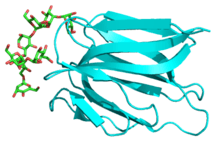Griffithsin
| Griffithsin | |
|---|---|
 | |
| Identifiers | |
| Organism | |
| Symbol | GRTF |
| PDB | 3ll2 More structures |
| UniProt | P84801 |
Griffithsin is a protein isolated from the red algae Griffithsia. It has a 121-amino acid sequence[2] which exhibits a Jacalin-like lectin fold. Several structures of this protein have been solved by X-ray crystallography and deposited in the PDB. It has been shown in vitro to be a highly potent HIV entry inhibitor. It is currently being investigated as a potential microbicide for use in the prevention of the transmission of HIV. [3]
Griffithsin shows a broad spectrum ability to bind to the glycoproteins of other viruses, such as the coronavirus. Griffithsin's three identical carbohydrate domains bind to specific oligosaccharides on the envelope of viral glycoproteins. This was demonstrated by in vitro and in vivo studies.[4] For instance, it was shown that griffithsin binds to the SARS-CoV spike glycoprotein to inhibit entry of the SARS virus and thus inhibit infection. A 2014 study showed griffithsin to also possess useful antiviral activity against Ebolavirus.[5]
As reported in March 2009, Kenneth Palmer and coworkers modified the tobacco mosaic virus to incorporate the griffithsin gene and infected more than 9,300 tobacco plants. They were able to extract enough griffithsin to produce about 100,000 HIV microbicide doses from the leaves.[6]
References
- ↑ Moulaei, T.; Shenoy, S. R.; Giomarelli, B.; Thomas, C.; McMahon, J. B.; Dauter, Z.; O'Keefe, B. R.; Wlodawer, A. (2010). "Monomerization of Viral Entry Inhibitor Griffithsin Elucidates the Relationship between Multivalent Binding to Carbohydrates and anti-HIV Activity". Structure. 18 (9): 1104–1115. doi:10.1016/j.str.2010.05.016. PMC 3399781
 . PMID 20826337.
. PMID 20826337. - ↑ Mori T, O'Keefe BR, Sowder RC, et al. (2005). "Isolation and characterization of griffithsin, a novel HIV-inactivating protein, from the red alga Griffithsia sp". J. Biol. Chem. 280 (10): 9345–53. doi:10.1074/jbc.M411122200. PMID 15613479.
- ↑ Emau P, Tian B, O'keefe BR, et al. (2007). "Griffithsin, a potent HIV entry inhibitor, is an excellent candidate for anti-HIV microbicide". J. Med. Primatol. 36 (4–5): 244–53. doi:10.1111/j.1600-0684.2007.00242.x. PMID 17669213.
- ↑ O'keefe BR, et al. (2010). "Broad-Spectrum in Vitro Activity and In Vivo efficacy of the Antiviral Protein Griffithsin against Emerging Viruses of the Family Coronaviridae". Journal of Virology. 84 (5): 2511–2521. doi:10.1128/JVI.02322-09. PMC 2820936
 . PMID 20032190.
. PMID 20032190. - ↑ Barton, C; Kouokam, J. C.; Lasnik, A. B.; Foreman, O; Cambon, A; Brock, G; Montefiori, D. C.; Vojdani, F; McCormick, A. A.; O'Keefe, B. R.; Palmer, K. E. (2014). "Activity of and effect of subcutaneous treatment with the broad-spectrum antiviral lectin griffithsin in two laboratory rodent models". Antimicrobial Agents and Chemotherapy. 58 (1): 120–7. doi:10.1128/AAC.01407-13. PMC 3910741
 . PMID 24145548.
. PMID 24145548. - ↑ Palmer, Kenneth E.; et al. (2009). "Scaleable manufacture of HIV-1 entry inhibitor griffithsin and validation of its safety and efficacy as a topical microbicide component". PNAS. 106 (13): 6099–104. doi:10.1073/pnas.0901506106. PMC 2662964
 . PMID 19332801.
. PMID 19332801.